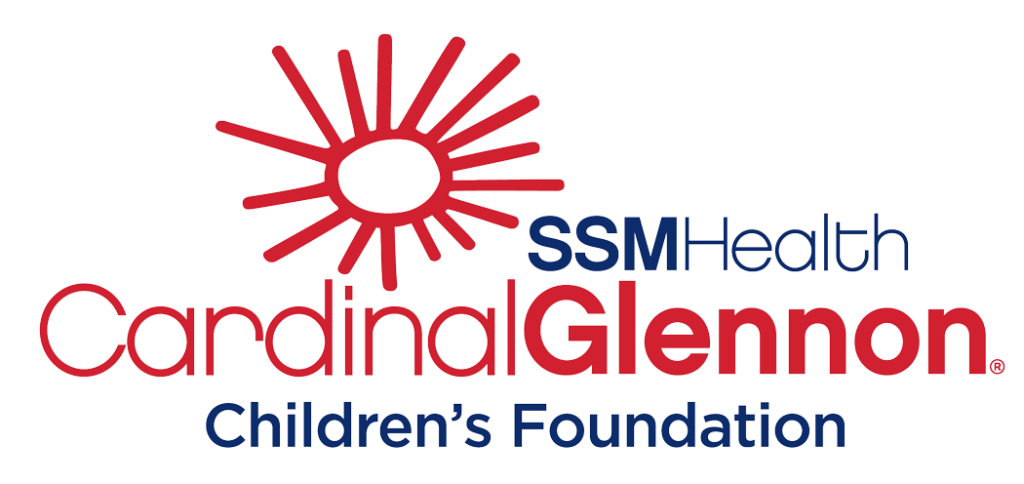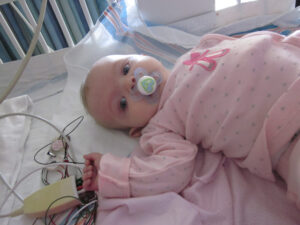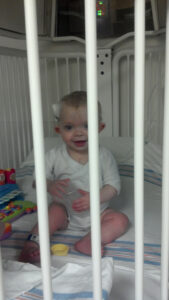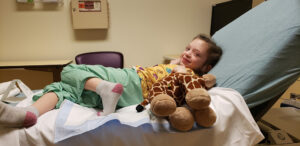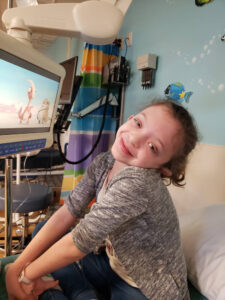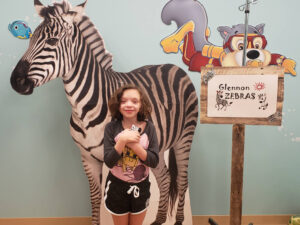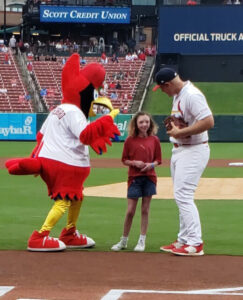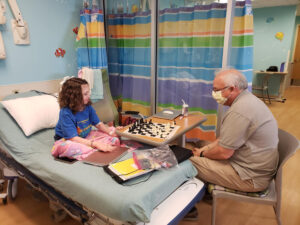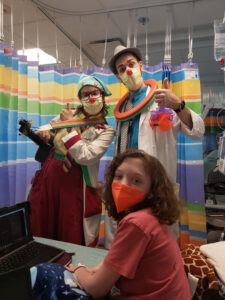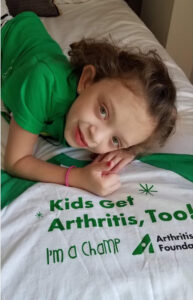Our Patients:
Morgan Andrews

Courtney Andrews gave birth to her daughter, Morgan on March 6, 2011. “I had a pretty routine pregnancy, despite some mild preeclampsia and polyhydramnios. Morgan was born after a shoulder dystocia, weighing 9lbs 11oz. She had difficulties with feeding and they told me she had a slight heart murmur. They did an echocardiogram on her, but we were discharged home with only your standard plans for routine well visits and check-ups,” said Courtney.
At Morgan’s 8-week checkup, the pediatrician noticed Morgan had had some distinguishing facial features. The heart murmur had persisted, and she had also lost weight. At that visit, their pediatrician referred Morgan to see a gastroenterologist and cardiologist. Both specialists saw her the next day. The gastroenterologist referred Morgan to Genetics. The cardiologist, upon further examination, found a heart defect – left ventricular diverticulum. The Genetics team began exploring various syndromes Morgan might have. Over the next 6 months, Morgan was tested for multiple syndromes and they were told that she would eventually need heart surgery.
Morgan had a cardiac CT at 4 months of age. At 6 months of age, she had open heart surgery with Dr. Charles Huddleston. Genetic testing also revealed around that same time that Morgan had Noonan Syndrome. Noonan syndrome is a genetic disorder characterized by short stature, distinctive facial features, heart defects, bleeding problems and skeletal abnormalities. It also can cause a child to develop more slowly than usual, for example, in walking, talking, or learning new things. Doctors manage Noonan syndrome by controlling the symptoms and complications.
“As a younger child, Morgan was sick a lot of the time,” recalls Courtney. “She frequently had fevers and illnesses making it difficult to keep her in a day care setting. It seemed like she was on oral steroids and antibiotics every 6-8 weeks,” Courtney said. “I used to work outside the home before Morgan was born,” Courtney said. “I was a senior statistical snalyst for a managed care firm. Given the lack of available leave and Morgan’s heart surgery on the horizon, I left my position to avoid being terminated when I ran out of leave. I took on multiple part-time positions that allowed me to flex my schedule while still supporting my family. We had 18 months of Cobra before Morgan transitioned to Missouri’s high risk pool insurance. When our former hospital did not adopt that plan, we transitioned Morgan’s care to SSM Health Cardinal Glennon. Morgan was around 2 years old at that point”, Courtney recalls. Morgan initially saw endocrinology, the sleep clinic and neurology at Glennon, followed by pulmonology and ophthalmology. “Not long after this, given Morgan’s frequent illnesses we saw Dr. Alan Knutsen, in Allergy and Immunology at Glennon” Courtney said.
“Morgan was diagnosed with primary immunodeficiency. She initially started with prophylactic antibiotics, and eventually Morgan began IVIG infusions,” Courtney said. Just recently Morgan was able to stop the infusions and so far, is doing good!
With frequent fevers, rashes and joint complaints Morgan’s pediatrician, also an SSM physician, referred Morgan to rheumatology, after working with dermatology to attempt to address the rashes. After assessment by Dr. Austin Dalrymple, it was determined around age 5 that Morgan also has Juvenile Idiopathic Arthritis. It took some time to find just the right combination of medications or therapies to get Morgan’s arthritis under control. She started with NSAIDs, then Methotrexate, then added a biologic, Humira. Upon relapse she started Remicade infusions in 2020 at the beginning of the pandemic. Thankfully she has reached medicated remission and has been able to discontinue all other medications and is starting to decrease the dose of Remicade.
Like many individuals with Noonan Syndrome, Morgan has encountered a variety of medical issues. Given the results of additional genetic testing, Morgan had a head CT and MRI which revealed that Morgan had mild cerebellar tonsillar ectopia,” said Courtney. This isn’t uncommon in Noonan Syndrome. Upon repeat imagining, it had not changed and since Morgan was asymptomatic, her care team decided that surgery was unnecessary and that they could follow up with imaging in the future if symptoms arose. Morgan also has issues with GI dysmotility, as well as a bleeding disorder, also more common in Noonan Syndrome. And most recently was diagnosed with coronary ectasia.
Over the years, Morgan has seen specialists from Hematology, Genetics, Rheumatology, Immunology, Dermatology, Ophthalmology, Gastroenterology, Endocrinology, ENT, Pulmonology, Neurology, Neurosurgery, Sleep Clinic, Orthopedics, Cardiothoracic Surgery, the Complex Care Team, Speech Therapy, Occupational Therapy and Physical Therapy. She struggled in school for several years due to absences and illnesses, at one point being approximately 3 years behind academically compared to her peers. Between success with a reading interventionist, Special School District and the necessary isolation of the pandemic, Morgan turned a huge corner. “Parkway had an amazing virtual program during the pandemic which gave Morgan a LIVE teacher almost every day. By 6th grade, Morgan was caught up in school, she was almost never sick and making mostly A’s and B’s!” exclaimed Courtney.
When she is not at the hospital, Morgan the youngest of three, enjoys Girl Scouts, youth group, swimming, theater (especially Hamilton and Mean Girls), swings and playing with her neighbors. She is a very happy child and wants to be a Child Life Therapist when she grows up and says she has definitely been influenced by her Glennon Child Life Therapists and her time with them in the hospital. “I feel like I’m good with kids and I really like helping people,” says Morgan. “They’ve made my time here more fun. They share pictures of Thor (Facility Dog) to help me through infusions, and they just really help make the time pass so much easier,” says Morgan. “My favorite part of Cardinal Glennon has to be my nurses, especially Debbie and Bonnie,” says Morgan. They know what I like and don’t like, as well as what scares and upsets me. They’ve known me since I was little and I feel like they are always looking out for me,” Morgan says.
“People at Glennon are always looking at Morgan’s quality of life and what’s best for her,” Courtney says. “Her doctors treat both of us as partners in her care. They’re patient when I bring up research articles I only vaguely understand and they welcome discussion about Morgan’s options. There is another children’s hospital approximately 5 minutes from our home. Morgan could have her infusions there, and their infusion center has incredible amenities including a gaming center, a therapy dog, relaxation pods and more. When I asked Morgan if she’d prefer to have her treatments there instead of Cardinal Glennon, she asked if her nurses from Glennon would be there. She said that she would never leave her nurses at Cardinal Glennon and that none of that stuff can be better than the people at Glennon. For a 12 year-old to say that, it speaks volume to the quality of care at Cardinal Glennon and the impression that they have left on Morgan since she has been coming here,” Courtney says. “Laying that groundwork of trust is so important when you are a child and a family living with chronic conditions and a lot of unknowns. From the physicians to the nurses, to the volunteers at her appointments we have definitely found an exceptional care team.”
